Safeguarding Adult Review Policy
This policy provides guidance on the North Yorkshire Safeguarding Adults Board (NYSAB) Safeguarding Adult Review (SAR) Framework. It is designed to assist people to decide when to refer a case for consideration as a SAR, as well as providing guidance on the SAR process itself.
1.1 The Care Act 2014 provides a statutory basis for learning and review processes. Safeguarding Adults Reviews (SARs) provide an opportunity to learn lessons when abuse or neglect is suspected to be a factor in the death or serious harm of an adult with care and support needs.
1.2 It is the responsibility of all partner agencies to make a referral for a SAR where there are reasonable grounds to consider the criteria for a SAR are likely to have been met.
1.3 All partner agencies have a responsibility to ensure that staff know the criteria for a SAR, their purpose and function. All partner agency staff must know how to refer a case for consideration via the NYSAB Business Unit.
1.4 The SAR related meeting structure can be seen below: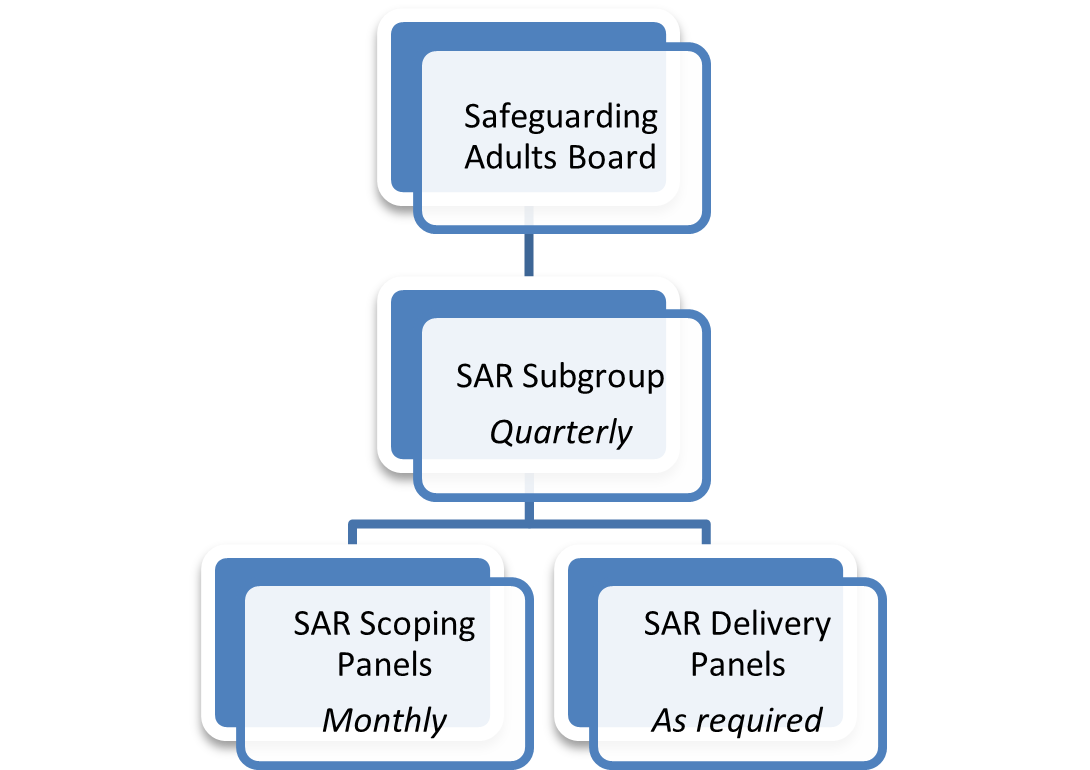
1.5 The quarterly SAR Subgroup maintains oversight of and monitors progress of all SARs. Underneath this, SAR referrals are received into individual monthly SAR Scoping Panels. These will consider whether the referral meets the criteria to conduct a SAR, a decision which is ultimately ratified by the NYSAB Independent Chair.
1.6 A SAR Scoping Panel must include an appropriate senior representative from the following agencies:
1.6.1 North Yorkshire Council (NYC) Health and Adult Services (HAS)
1.6.2 North Yorkshire Police
1.6.3 Humber and North Yorkshire Health and Care Partnership (ICB)
1.7 A SAR Scoping Panel will be considered quorate with representation from the three statutory agencies (North Yorkshire Police, Local Authority and Integrated Care Board), who are required to be of appropriate seniority and experience.
1.8 Other relevant representatives that have had involvement with the case will be invited as required, to assist with decision making around S44 criteria.
1.9 The NYSAB, via its Independent Chair, is the only body in North Yorkshire that commissions SARs.
1.10 Commissioned SARS will be actioned via SAR Delivery Groups, with progress fed back into the SAR Subgroup.
1.11 The policy and practice undertaken by the NYSAB strives to reflect the SAR Quality Markers published by the Social Care Institute for Excellence (SCIE). A copy of the markers can be found here: https://www.scie.org.uk/safeguarding/adults/reviews/quality-markers
2.1 The SAR is a statutory learning-focused process, designed to have practical value by illuminating barriers and enablers to good practice, untangling systemic risks, and progressing improvement activities.
2.2 The purpose of a SAR is to determine where multi-agency working went well and what might have been done differently that could contribute towards preventing similar harm or death reoccurring in the future. It therefore requires outcomes that:
2.2.1 Establish what lessons can be learnt from the particular circumstances of a case in which professionals and agencies were involved in the care and support of an adult at risk of abuse and / or neglect
2.2.2 Review the effectiveness of safeguarding systems, procedures and practice both of individual organisations and multi-agency arrangements.
2.2.3 Inform and improve future practice by acting on the findings (developing best practice across all organisations)
2.2.4 Highlight any good systems, procedures, practice or opportunities to improve, identified within the review.
2.2.5 Lead to recommendations to be implemented.
2.3 The purpose of the review is not to identify or apportion blame or hold any individual or organisation to account as other processes exist for this, including coronial procedures, criminal proceedings, disciplinary procedures, employment law and professional regulation.
3.1 The criteria for a SAR is when:
a. an adult in the NYSAB area has care and support needs (whether or not the local authority was meeting any of those needs);
and
b1. either dies, and the NYSAB knows or suspects that the death resulted from abuse or neglect (whether or not it knew about or suspected the abuse or neglect before the adult died)
Or
b2. NYSAB knows or suspects that the adult has experienced serious abuse or neglect (whether or not it knew about or suspected the abuse or neglect before the adult died or serious or significant harm occurred).
and in both cases
c. there is reasonable cause for concern about how the NYSAB, members of it (or other persons with relevant functions) worked together to safeguard the adult.
d. or the Safeguarding Adults Board believes that there is learning to be identified / embedded for future use / reference.
3.2 Where the mandatory SAR criteria is met a SAR must be commissioned. A SAR will be led by an author who will be responsible for undertaking the review, developing the recommendations and writing the report. In most cases, this will be an independent author commissioned to undertake the SAR on behalf of the NYSAB. The Independent Chair will then consider how this is done and whether a full review needs to be undertaken if the learning has already been identified but not yet actioned. e.g. learning has been taken from a similar SAR, or consideration of thematic reviews.
3.3 Where referrals relate to individuals who have died or been seriously injured within North Yorkshire area, but it is more appropriate for another area to conduct a review or another SAB, this will be considered by the independent Chair who will discuss the matter with the appropriate board Chair. The default position in the absence of agreement will be that the SAB where the death or injury occurred will be the commissioning board.
3.4 The NYSAB may also undertake a SAR in situations where it believes that there will be value in doing so. This may be where a case can provide useful insights into the way organisations are working together to prevent and reduce abuse and neglect of adults and can include exploring examples of good practice. This will be actioned at the discretion of the SAR Scoping Panel and with agreement by the NYSAB chair.
3.5 Following a significant event, active consideration should be made as to whether or not a referral for a SAR is required. To support this, organisations should consider including an appropriate trigger question on internal incident reporting, investigation and/or review templates, or have appropriate mechanisms in place to be able to readily identify scenarios that require referring into the SAR process.
3.6 It is important to note that the SAR notification process does not affect any internal review processes.
3.7 Section 45 of the Care Act 2014 establishes the importance of organisations sharing with the SAB information relating to the abuse or neglect of people with care and support needs. If the SAB requests relevant information from an organisation or person, then section 45 of the Act creates a legal duty for that body or person to share what they know with the SAB.
3.8 In the context of SARs, something can be considered serious abuse or neglect where, for example, the individual would have been likely to have died but for an intervention, or has suffered serious or significant harm as a result of the abuse or neglect.
4.1 Any agency representative, local councillors, Members of Parliament or professional MUST refer a case believed to meet the threshold of the criteria identified above (see 3.1 a., b. and c.)in a timely manner, by completing the SAR Referral Form and Decision Record (Appendix 1) and submitting it to the NYSAB Business Unit via email address: nysab@northyorks.gov.uk, or post: NYSAB, North Yorkshire Council, County Hall, Racecourse Lane, Northallerton, England, DL7 8AD
4.2 A case may also be referred by other interested parties including the family as above.
4.3 The SAR Scoping Panel may choose to invite those making a referral in their professional role to present the case to the panel. This is to enhance the opportunity to understand fully the context of the case prior to a decision being made.
5.1 Within 5 working days, on receipt of a referral, the NYSAB Business Unit will:
acknowledge the notification,
quality check the referral, and seek further information if required
advise the SAR Subgroup Chair and NYSAB Independent Chair of the referral.
5.2 Where the SAR referral does not indicate the statutory criteria are met, the NYSAB Business Unit may ask the referrer to provide further information. If upon receipt of further information it is clear the referral will not meet the s.44 criteria, the referral will not be progressed. The referrer will be notified of the outcome by a member of the Business Unit and recorded using part 2 of the SAR Referral Form and Decision Record (Appendix 1).
5.3 Once the referral is accepted, a Safeguarding Adult Review – Initial Request for Information (Appendix 2) will be issued to each partner agency by the NYSAB Business Unit. This includes any services that have had involvement with the person. The purpose of this is to collect relevant information that adequately informs the discussion on whether the SAR criteria are met.
5.4 Accepted SAR referrals will be considered at the next monthly SAR Scoping Panel meeting, providing this is quorate. If not, then an extraordinary meeting will be arranged.
5.5 In deciding whether a SAR should be recommended, the SAR Scoping Panel must first consider whether the s.44 criteria for a SAR is met using the criteria outlined in paragraph 3.1 above.
5.6 Appropriate scrutiny should be given in relation to the Safeguarding Adult Review – Initial Request for Information when determining whether the statutory criteria are met.
5.7 When considering a SAR referral, the SAR Scoping Panel will need to establish if there is learning from a multi-agency or single-agency perspective. It is important that consideration be given to the increasingly complex landscape of the commissioning and provision of services.
5.8 Each member will need to provide a verbal/written rationale for their decision as to whether the SAR criteria is met. The NYSAB Business Unit are not part of the decision-making process.
5.9 The SAR Scoping Panel’s recommendation as to whether the SAR criteria is met will be forwarded to the NYSAB Independent Chair who will make the decision as to whether to undertake SAR, and if so how it should be completed. The referrer will be notified of the outcome by a member of the Business Unit and recorded using part 2 of the SAR Referral Form and Decision Record (Appendix 1).
5.10 If a recommendation cannot be reached by consensus, a majority decision will be shared with the NYSAB Independent Chair who will decide whether the criteria is met and whether to undertake a SAR.
5.11 The SAR Scoping Panel may consider that although the mandatory s.44 criteria is not met, there will be benefit in conducting a SAR to promote effective learning and improvement action in order to prevent deaths or serious harm occurring in the future, under s.44(4) of the Care Act 2014. These reviews can provide useful insights into the way organisations are working together to prevent and reduce the abuse and neglect of adults in North Yorkshire.
5.12 The SAR Scoping Panel can recommend the following where the mandatory or discretionary criteria for a SAR are NOT met:
a. No further action
b. Commission a SAR
c. The SAR Scoping Panel will also consider and identify what single agency reviews may provide learning. This might involve separately, more than one agency. The group should state whether the agencies identified have agreed to undertake a single agency review.
5.13 It will be important to advise the SAR Scoping Panel of any governance issues and/or if other parallel proceedings are involved, for example, police investigations or Patient Safety Incident Response Framework. If a person has died, the NYSAB Business Unit may contact the Coroner to identify whether an inquest has or will be held.
5.14 The SAR Scoping Panel will also consider whether another review or learning process has already commenced which NYSAB could potentially feed into, e.g., Domestic Homicide Review [DHR], Learning Disabilities Mortality Review [LeDeR]., however if mandatory criteria are met the NYSAB must carry out a SAR.
5.15 SAR process will not as a matter of course share material gathered as part of the SAR with another agency or parallel proceedings without the consent of the NYSAB Independent Chair.
5.16 Should the referrer challenge the decision of the SAR Scoping Panel the Independent Chair of the NYSAB will respond. The decision can be re-visited if new information has come to light. Any challenge to the decision should be made to the Independent Chair of the NYSAB via the Business Unit e-mail within 28 days of the feedback being received.
5.17 The Business Unit will support the SAR Subgroup to keep a record of all cases that have been referred and considered for a SAR.
Where the s.44 criteria is met, the NYSAB Independent Chair is responsible for deciding whether a review is undertaken or not, and agreeing the rationale for this. For instance, in some cases learning may already have been gathered through an alternative learning process and another review would only duplicate this learning.
Once the decision has been made to instigate a SAR, the Business Unit on behalf of the NYSAB Independent Chair will write to the nominated lead of each organisation concerned advising advise them that a SAR has been commissioned and requesting them to nominate an appropriate senior member of staff to support the review process (see Appendix 4). Contact will be made with the Senior Investigating Officer from the relevant police force if criminal investigation is underway, to ensure any review does not undermine police investigations. The SAR may include information already gathered through other investigations (e.g., Safeguarding Enquiries or Adult Social Care Serious Incident Reviews).
The SAR Scoping Panel will identify and convene (via the Business Unit) an appropriate SAR Delivery Group to meet at the earliest opportunity. The SAR Delivery Group will comprise of relevant senior representatives from the key organisations involved in the case – this will usually follow the same membership as the SAR Scoping Panel. A Chair will also be appointed to lead the SAR Delivery Group.
The relevant SAR Delivery Group will be responsible for progressing the SAR process from commission through to action planning.
The methodology selected by the SAR Delivery Group must offer the most effective learning and involvement of key staff/family weighed against the cost, resources and length of time required to conduct the review.
The SAR Delivery Group will create the Terms of Reference which will outline the most proportionate and appropriate methodology and avoid the potential for duplication of learning elsewhere. They will reference the six safeguarding principles set out in the Care Act and NYSAB’s Multi-Agency Safeguarding Policy and Procedures and specify the time parameters of the SAR. The Terms of Reference should require an appropriate pseudonym unless otherwise agreed by the Chair. The SAR Sub-group and SAB chair reserve the right to not use the real name of a person if they feel it could prevent future trauma or risk.
An Independent Author (IA) with the requisite knowledge, skills, experience and availability will be identified to undertake the SAR. Where an IA is commissioned, formal procurement processes for appointing an independent reviewer will be followed. The selection of an IA will include a declaration that the IA does not hold any conflicts of interest in accepting this appointment. If any arise during the process of the review the IA must declare this at the earliest opportunity to the SAR panel.
The IA will be given access to related sensitive information via a secure platform, e.g. Egress mail, NYDrive, SharePoint or another closed secure network.
The SAR Delivery Group and the Independent Author once identified, should consider and record who will and will not be consulted as part of the review and the rational for doing so.
Where the subject of the review is alive, the SAR Delivery Group will give consideration to a communication plan within in the Terms of Reference. This will outline who is responsible for liaising with the person and/or their representative, and which relevant legal requirements will need to be followed. See Appendix 5 for further details about consent.
Where there is agreed involvement of the person and/or their family, then in discussion with them, the SAR Delivery Group and the author, will agree how they and the interested party will be involved during the preparation of the report and in the final written report.
The SAR Delivery Group will nominate and agree an individual within the SAB partnership to communicate with the family whilst the SAR is being undertaken. See Appendix 5 for further guidance. Where the person and/or their family do not wish to be involved in the development of the report this will be respected. However. they will still be offered an opportunity to review the draft report via a method as agreed with them with support if required.
Via the NYSAB Business Unit, the NYSAB Independent Chair will write to the family or significant others in cases where the subject is no longer alive to inform them of the SAR, explain the process and purpose, and inform them of their point of contact. This should be completed as soon as practically possible. Reasonable and appropriate support and adjustments should be made by NYSAB as required to enable the adult(s), their family and/or representatives to participate in the SAR.
Once the IA has been contracted, the timescales for completing the SAR will commence. Every effort will be made to complete the review within six months from which the IA is appointed. Where this will be not be possible, the matter will be discussed at the SAR Subgroup meeting and with the NYSAB Independent Chair. Updates will be recorded in the minutes of the SAR Delivery Group and SAR Subgroup meetings. Interested parties, such as the family will be notified as felt appropriate.
The SAR Delivery Group will at key times as agreed during the SAR process to monitor progress and discuss whether any amendments to the Terms of Reference are required.
Nominated agency representatives are required under the Care Act 2014 to supply all information that may be relevant to the SAR within the identified time parameters. They must ensure that they coordinate with other relevant members of their organisation to obtain the fullest understanding of their interactions.
Nominated agency representatives also have a responsibility to explain the SAR process to others in their organisation and provide reassurance and support to their colleagues throughout the process. This support should be clearly identified and communicated to all staff involved. The death or serious injury of an adult at risk will have an impact on staff and may be felt beyond the individual staff involved to the team, organisation or workplace.
The SAR Subgroup will receive and agree the draft report before it is presented to NYSAB, so that individuals are satisfied that the panel’s analysis and recommendations have been fully and fairly represented.
The adult(s), if alive, to which the SAR relates and if appropriate, their family or representatives should also be given the opportunity to see the SAR report and recommendations. Ordinarily, two weeks will be afforded to read the SAR and provide any response. However, extensions will be granted at the discretion of the SAR Subgroup Chair if deemed appropriate to do so.
Once it has been agreed to commission a SAR, the SAR Delivery Group will decide on the most appropriate and proportionate methodology to use. See Appendix 4 for further guidance. The Care Act statutory guidance indicates that, whichever SAR methodology is employed, the following elements should be in place:
SAR Delivery Group – scrutinises information submitted to the review. The panel size should be proportionate to the nature and complexity of the review, but should comprise a minimum of three members in addition to an appropriate chair, independent from who made the referral, and any other relevant agencies.
SAR Delivery Group Chair – independent from who made the referral, and with appropriate skills, knowledge and experience (see below)
Terms of Reference – compiled by the SAR Delivery Group and published as part of the review. These may be amended in consultation with the contracted author.
Early discussions with the adult if alive and if appropriate, their family, carers and representative – to agree on if and if so, how they will be involved and how frequently they will be updated. Where appropriate, advocacy can be offered. See Appendix 5
Appropriate involvement of professionals and organisations who were working with the adult – to contribute their perspectives without fear of being blamed for actions they took in good faith
SAR report and recommendations
7.2 The following should be considered in selecting a SAR methodology: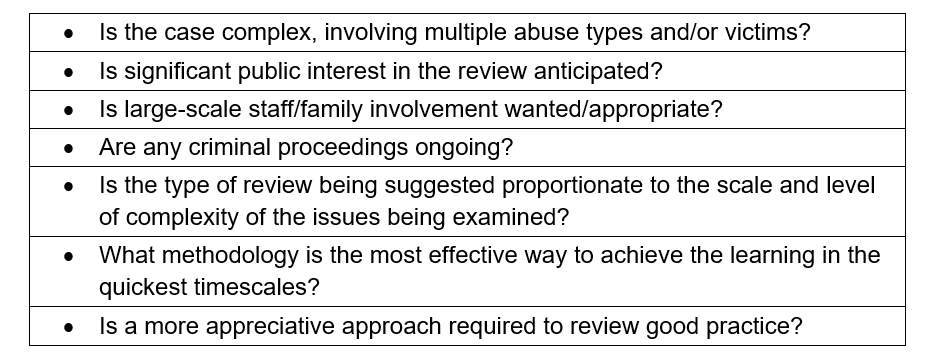
8.1 The SAR report should:
Highlight key episodes, providing insight into good practice and opportunities to improve practice, systemic risks and multi-agency working to enable recommendations that will recognise best practise
– Identify need for change to prevent similar incident re-occurrence.
– It should be written with a view to being published.
– Details of the person are included as judged necessary to illuminate the learning having been considered in line with the wishes
of the individual or their family.
8.2 The SAR delivery group has a responsibility to ensure there has been sufficient analysis, scrutiny and evaluation of evidence throughout the process. Recommendations must be of practical value, evidencing the wider outcome focused learning identified about routine barriers and enablers to good practice, systemic risks and/or what has facilitated or obstructed change to date.
8.3 The NYSAB Business Unit will make appropriate arrangements for the SAR report and other records collected or created as part of the SAR process, to be held securely and confidentially for an appropriate period in line with NYSAB’s information sharing agreement, the General Data Protection Regulation (GDPR) and any other legal requirements.
8.4 When the review has been completed and signed off by the Board, the SAR Subgroup will consider if, how and when the review will be published, taking into account any sensitivities and parallel proceedings. The SAR Subgroup will make a recommendation to the NYSAB Chair.
9.1 The NYSAB is responsible for ensuring any learning identified within the report has clear recommendations to action change. The SAR Delivery Group will deliver on the recommendations via an Action Plan which must be SMART (Specific, Measurable, Achievable, Relevant and Time bound).
9.2 The SAR Delivery Group is responsible for identifying an owner for each action and monitoring the actions on the composite action plan. It is the responsibility of NYSAB members to ensure that learning and service change from any safeguarding review is understood, embedded and evidenced with their organisation. NYSAB members will be held accountable for these actions at board meetings and via the SAR Delivery Group and SAR Subgroup.
9.3 An action plan will be held by the SAR Delivery Group who will meet a minimum of four times a year to review and check progress on each action. Quarterly feedback will be fed into the SAR Subgroup.
9.4 When all actions are completed, the SAR Subgroup will recommend the action plan for closure to the NYSAB Exec.
9.5 Further assurance will be sought by the SAR Subgroup 12 months thereafter to ensure changes in practice have been embedded.
9.6 Regular reports on the overall work of SAR Subgroup including ‘live’ referrals, action plans, including any themes and reviews will be presented to the NYSAB by the SAR Subgroup Chair.
10.1 The appropriate publication should be timely and publicise the key systemic risks identified through the SAR. Publication of the SAR will ordinarily be managed through the NYSAB website but adapted as necessary for the needs of different audiences. Decisions about what, when, how and for how long to publish and disseminate findings are made with sensitive consideration of the wishes and impact on the person, family and others. A pseudonymised report will usually be published unless the NYSAB Independent Chair agrees there are exceptional circumstances not to do so. In such an event, consideration will be given to what alternative approaches can be taken to publicise the outcomes, recommendations and learning gained by the review.
10.2 As North Yorkshire Heath and Adult Services are the lead agency for adult safeguarding, media and communication activity about the SAR will be co-ordinated by the North Yorkshire Council’s Communications Unit on behalf of the Board and communication teams for other agencies involved in the SAR will be consulted as appropriate. North Yorkshire Council’s Communications Unit will be briefed as soon as a decision has been made to undertake a SAR and will be kept up to date with the progress of the review by the SAR Subgroup Chair or nominated officer.
10.3 The NYSAB must include the findings from any SAR in its annual report and include what actions it has taken, or intends to take, in relation to those findings. Where the NYSAB is unable to implement a recommendation then it must state the reason for that decision in the annual report. The NYSAB maintains a public record, actions and commentary to enable public accountability.
10.4 It will be NYSAB’s intention that SAR publications will be submitted for inclusion in the national SAR library.
10.5 Where the recommendations for a SAR are linked to national issues and government policy, these will be escalated to the National SAB Chairs Network via the NYSAB Independent Chair. Any actions accepted by the national group will be updated as such on the SAR action tracker and closed pending an update.
10.6 It should be noted that SARs sit outside of any NYSAB partner retention policy.
11.1 It is recognised that disputes may arise at any stage during the SAR process, including whether a SAR should be commissioned, how it is commissioned and any aspect of the outcome of the review, including the content of the report. A dispute may arise because of a disagreement or complaint from anyone involved in the SAR process.
11.2 The NYSAB retains ultimate responsibility for the SAR process. Where a dispute arises, it shall be dealt with as follows:
a) Those responsible for the relevant part of the SAR process shall attempt to resolve the dispute, for example, the SAR Delivery Group and/or the IA during the carrying out of a review. Any concern that cannot be resolved with be escalated to the NYSAB Independent Chair for a final decision.
b) For disputes relating to the report content, the objecting party will provide written representation setting out their concerns to the SAR Delivery Group within five working days of being advised that the final draft report will not be amended.
Where the NYSAB Independent Chair is unable to resolve the dispute, they may recommend that a reference to the dispute, and why it was not possible to resolve, should be included as an addendum to the report.


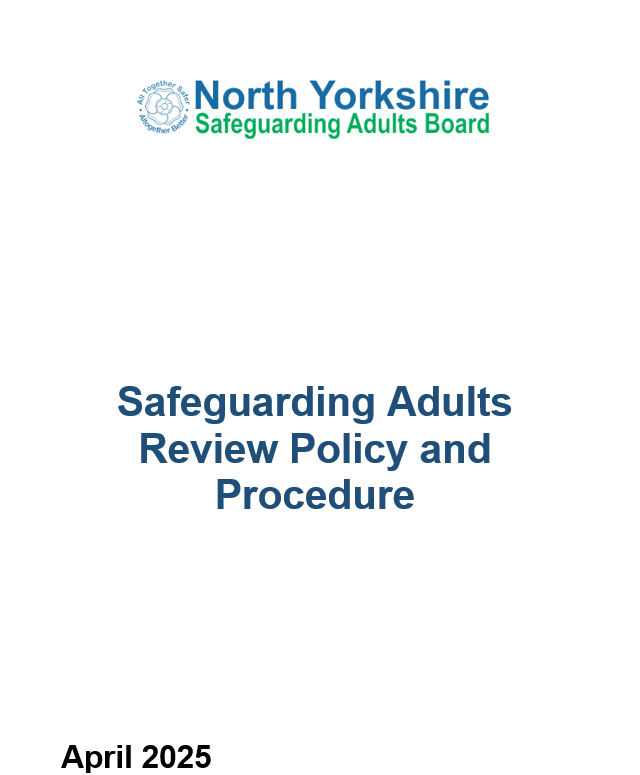

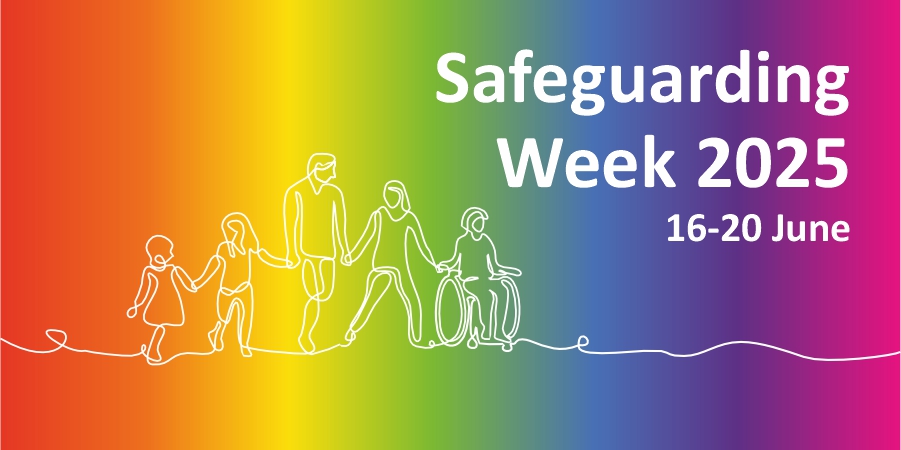
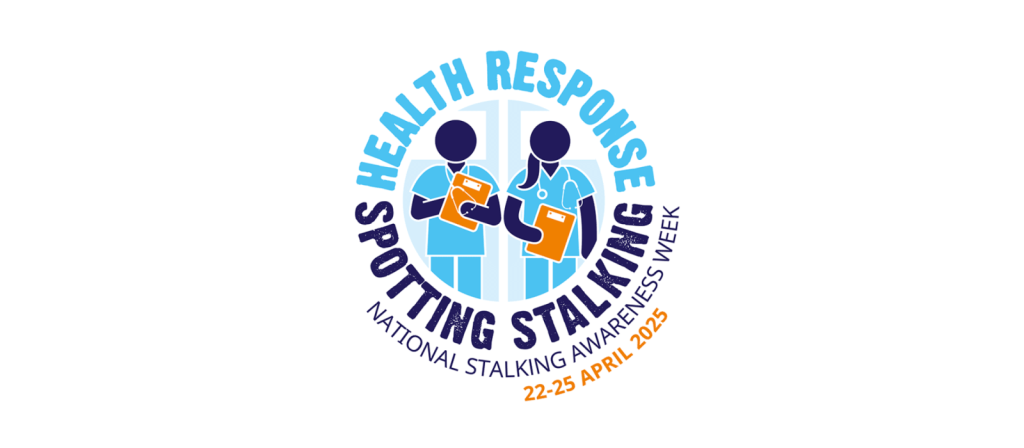
 View all our news
View all our news